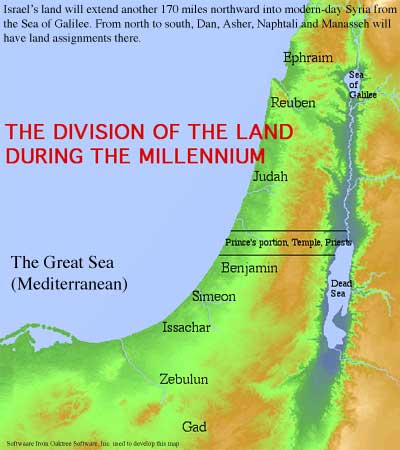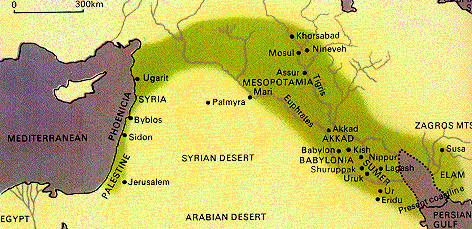Weekend Bible Study---Ezekiel
Notes and references on Ezekiel.
Ezekiel 48
Here is a link to a diagram of the way Israel is divided.
The future division of the land.

On the right is one persons visualization. But the odd thing about this is the straight line borders from west to east. This seems doubtful given the geography.
The Ezekiel Temple
First, I asked for suggestions on a Bible that translates the dimensions of the Temple for helping the reader visualize things. One suggestion is The Good News Bible. Another is the New Living Translation. There are probably more you can find at Bible Gateway.com.
Here is a site that has a visual rendition of what the Temple might look like. It is down the page.
Ezekiel 40
There is a wealth of material on the Internet about Ezekiel's temple, and it remains something of an Enigma.
R.J. Anderson lists four main questions which we can think about as we make our way through these passages, and they are as good a place to start as any:
1. Is the temple and its worship literal, or figurative?
2. Do these things take place at a time now past, or at some point in the future?
3. If the time is future, does it involve the millenial kingdom of Christ on earth, or the heavenly state?
4. In any case, what is the purpose of the sacrifices described?
Ezekiel 35
Location of Edom and Mt. Seir.
International Standard Bible Encyclopedia. 1939
Ezekiel 25: Here is a link to map showing roughly the locations of Ammon and Rabbah.
http://www.biblemap.org/#Ammon
The location of Temah, of Edom.
Ezekiel 28,29.30
On Q & A portion of the study, Beyond Paradox, by Simon Jacobson.
Ezekiel 26:
About Tyre. ISBE
Ezekiel 23
You Tube link for the Today show: Tyra Banks on the teen sex crisis.
Ezekiel 19
If you would like an example of an Allegory, see Pilgrim's Progress.
Recommended reading: Journaling, by Steve Pavlina.
Why Invasions into Palestine came from the North.

And, I suppose this also tracks the journey on foot for the exiles going to Babylon. Nobody wanted to cross that desert. Picture is linked to the source website.
Outline from the Holman Bible Dictionary. You may wish to modify it as we go along.
Outline
I. Introduction: Yahweh's Glory Watches Over the Captives in Babylon (1:1-28).
II. The Glory Brings Divine Judgment on Israel. (2:1-24:27)
A. By calling Ezekiel to be a prophet (2:1-3:27)
B. By predicting the fall of Jerusalem (4:1-5:17)
C. By condemning Jerusalem's idolatry and sins (6:1-7:27)
D. By describing and explaining why the Glory departed from the city (8:1-11:25)
E. By showing the futility of the nation's leadership (12:1-15:8)
1. The Davidic ruler would be taken into captivity. (12:1-28)
2. The false prophets and prophetesses would be swept away by a storm. (13:1-23)
3. The idolatrous community leaders had created such a state of alienation from Yahweh that prayer for deliverance would be ineffectual. (14:1-23)
4. Like a useless vine the city would be burned up. (15:1-8)
F. As a means of providing reconciliation (16:1-18:32)
1. In spite of Israel's ingratitude and unfaithfulness, Israel will be restored. (16:1-63)
2. In spite of the king's failure, a universal kingdom will flourish. (17:1-24)
3. On the basis of individual responsibility, the relationship between God and Israel will be maintained. (18:1-32)
G. Resulting in the nation's destruction (19:1-23:49)
1. In spite of the hopeless situations of their rulers (19:1-14)
2. Because of Israel's constant state of apostasy (20:1-49)
3. By means of a sword (21:1-32)
4. Because Israel refused to live by God's covenant demands (22:1-31)
5. Because of the two sisters' (Oholah and Oholibah) incessant immoralities (23:1-49)
H. As seen in two events of unparalleled sadness (24:1-27)
1. In the siege and destruction of Jerusalem (24:1-14)
2. In the death of Ezekiel's wife (24:15-27)
III. The Glory Brings Divine Judgment to the Nations. (25:1-32:32)
A. Against Ammon because of her joy over Israel's distress (25:1-7)
B. Against Moab because of her failure to recognize Israel's revelatory status (25:8-11)
C. Against Edom because of her lust for vengeance (25:12-14)
D. Against Philistia because of her perpetual hostility (25:15-17)
E. Against Tyre because of her greed for self-gain at Israel's expense (26:1-28:19)
F. Against Sidon because of her constant threat to Israel's welfare (28:20-26)
G. Against Egypt because of her pride and deceit (29:1-32:32)
IV. The Glory Brings Restoration to Israel. (33:1-48:35)
A. Through Ezekiel's faithful role as a watchman (33:1-33)
B. By means of the messianic leader, "my servant David" (34:1-31)
C. For the entire land (35:1-36:38)
1. By the total destruction of Edom (35:1-15)
2. In the deliverance of Israel (36:1-21)
3. In the implementation of the new covenant (36:22-38)
D. To revive the hopeless state of the people who felt they had perished (37:1-28)
E. By defeating the ungodly forces of the nations under Gog of Magog (38:1-39:29)
F. Resulting in the pure worship of the restored people (40:1-48:35)
1. With the throne of Yahweh's glory replacing the ark (40:1-43:12)
2. With the presence of Yahweh's glory providing far-reaching blessings (44:1-47:12)
3. With a firm inheritance in the land (47:13-48:35)
F. B. Huey, Jr.
